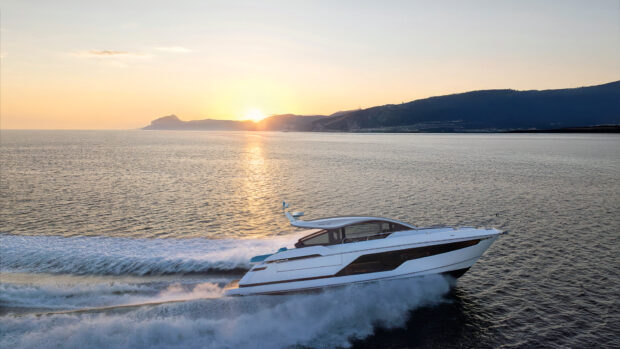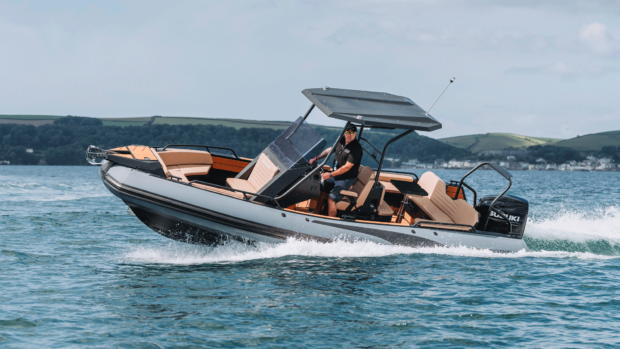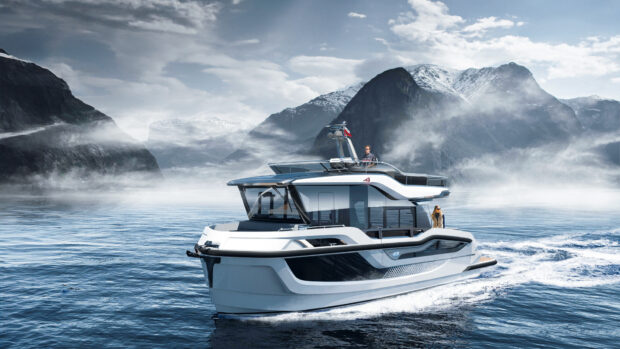Life at sea has its ups and downs, as the crew of Egret discover
Position: S22 11.58 W139 32.92
Scott (YT) and Mary Flanders (MS) left Gibraltar on 16 September 2006, and we’ll be following their journey every step of the way, thanks to this unique online “blog”. For a complete list of all the couple’s blog entries click here
Life at sea has its ups and downs, as the crew ofEgretdiscover
Friday 6 June
Well, mis amigos, Thursday night and early Friday morning (so far) have been as uneventful as life at sea can be…and that is good. However, our fishing has been unsucessful. We reached our first good fishing opportunity on Thursday evening just at dark. We Watched the huge surf break on the reef and we didn’t deviate an inch from our course to give it a go trolling near shore. Again this evening we will reach the first of the Duke of Gloucester Islands (Nukutepipi) after dark. Antoine told us that the first island is now inhabited, which means there is a cut in the reef. We would love to sneak inside the atoll and meet the locals, although the chances of them speaking any English would be slim. Our three words of conversational French wouldn’t be much help but somehow, as always, we imagine we would converse using smiles, pantomime, hand waving and a strong desire on both parties to be understood.
Yesterday our small JRC radar went quit working. It is flashing a ‘bearing pulse error’ code. The operator’s manual is zero help and doesn’t have a troubleshooting guide. There is no email address for service or the US headquarters. If we didn’t have a second radar we would burn Iridium time trying to sort this out enroute.
Radar is essential in and among these atolls. Once in Papeete we’ll use our Skype account at an internet cafe and see where this leads. So far we have found the atoll placement-matching radar (which never lies) tallies perfectly with our electronic charts (the only exception being the Duke of Gloucester Islands).
I moved the small radar myself five years ago from its initial location on the flybridge to the pilothouse which is more suitable for offshore boating. To do this I had to splice about a zillion small wires and wires and me don’ get on.
Thursday’s highlight was my discovery that if we moved the dock box from the indentation in front of the catamaran dinghy to the flybridge that we can turn the catamaran dink fore and aft on the starboard side with a perfect fit, rather than having the dink turned 45 degrees. This gives us more flybridge seating for guests and room for an aluminium-bottomed RIB. We’ll buy the largest one that will fit this space in New Zealand, with an 8hp Yamaha two-stroke, to replace the Zodiac we lost in Easter Island. We’ll still keep our trusty antique, wooden-floored 9ft dink in reserve.
Through our forum we have received information that we didn’t think of and which is important to EU readers. For the record, all of our fuel mileage or fuel related figures are in US gallons, which is 3.8litres, compared to a UK gallon of 4.56 litres.
Saturday 7 June
Daybreak. The sun is starting to set a little later each day as we move further north and west, which is a good thing. It’s depressing to have a fully dark sky at 5.30pm.
We are on a waxing moon so each evening the moon rises a little higher in the sky before setting and the stars are brilliant. Last night we watched the Southern Cross doing its rotation from vertical to horizontal. Mary was thrilled when she found the Big Dipper upside down low on the horizon way out to the north. Also on Mary’s watch she saw our first boat at sea since leaving mainland Chile. It was heading away (SSW) so it must have been a sailboat or supply ship heading for the Austral Islands. (The Australs and Gambiers are the most remote islands of French Polynesia). About midnight the seas started to pick up from astern in winds from 20 to 25 knots. The ride is still good – and most importantly good enough to fish…so far. Finally, today about Noon we will have a chance to explore an uninhabited atoll if the seas don’t build further.
My fishing buddy, who is joining us in Tahiti, sent an email in exasperation because we aren’t catching fish. He even offered advise so I had to send a letter explaining that when we are in fish territory we’ll catch fish. Near Easter Island we caught five fish in two hours. There were 18 boats on the Nordhavn Atlantic Rally, most of which were pulling baits. We travelled around 3900nm together andEgretcaught three fish and broke off two that were too big for our tackle. The entire fleet caught less than 10. Ten (10) fish by 18 boats in 3900nm. Not bad fishermen, simply no fish.
Saturday 7 June pm
OMNI Bob described today’s winds as “freshing”, a perfect description. All day long the winds have been increasing slowly to sustained winds over 20 knots. Also as predicted the wind and sea direction remains favourable, almost directly on the stern, increasing along with the wind. Our speed is in the 6.3-6.5 knot range (at 1350rpm) being pushed by the wind and following seas. Instead of threatening, the friendly seas are building behind the transom and are then passing under in a crush of bright white foam and such brilliant blue they almost look artificial. This makes such a difference from the endless grey seas of the Southern Ocean of just a few months ago. We are ever so slowly banking time for our hopeful intended late Monday afternoon arrival in Papeete, Tahiti This said, OMNI Bob predicts the wind to swing to the NE, NNE for a short period meaning seas forward of the beam, which would slow us considerably. In the give and take of passagemaking we still have the option of early Monday morning to increase speed to buy us a bit of time.
Along with the building seas went our diversion to the atoll that we passed a few hours ago. The favourable fishing side would have been smothered in heavy surf, not a friendly place to try to catch some fish.
Saturday late evening
The seas slowly continue to build along with the wind. It is impressive seeing the waves pop up in front of the pilothouse glass that have been disrupted on their journey to nowhere by our little white fibreglass ship. One minute there is moonbeam, the next a large black shape is spitting foam. We have increased our speed to 1400rpm to give us a little more flow past the stabilizer fins and the rudder. We have also turned down the Naiads that were starting to steer the boat from the seas racing past. Our speed increased immediately – four knots from a simple 50rpm increase and stabilizer adjustment. Cool.
Sunday 8 June
After daybreak. Grrrrrrrr. Let’s talk about how the domino principal affects cruising. I am cranky and I haven’t had much sleep. It’s not the seas’ fault (even though they are no longer kind). But it is the heat down below in the master cabin. Normally underway this is never a problem. We turn on the fans and that is the end of it. However, this is a cumulative heat from a hot engineroom and lack of ventilation. We are running downsea in fairly large seas with the wind behind us as well. I am not comfortable leaving the saloon door open at night with a single watch stander while we are being twisted now and again by an occasional large set of waves moving through. A single freak wave would cause havoc if it were to break intp the cockpit and the saloon door were to open.
Let’s cut to the chase and explain the extra heat and dominoes. Our freezer is nearly empty so it cycles much more than when full. Our freezer is also malfunctioning. It cools well enough but when trying to start it pulls an enormous AC load for quite a while until the compressor kicks in. That load in turn has to come out of the batteries through the inverter. The inverter is working very hard and like any type of physical work creates a lot of heat. The inverter is located under the refrigerator and freezer in the hot engineroom. A hot electrical device is not efficient. The alternator is working overtime trying to stuff amps back into the batteries to feed the overworked inverter feeding the freezer. More heat, less efficiency from the alternator and so more work from the alternator to make up for less efficiency. It’s simply maths.
The root of the problem is the malfunctioning freezer. A couple of years ago I installed two layers of 7mm close cell foam above the inverter area on the engineroom overhead. We also added a 3in of pancake (computer) 12V fan that runs 24/7 blowing down on the inverter exhaust to help dissipate heat. This normally works well. The bottom line and lesson to learn is that on board a single item not working properly can cause an unpleasant chain of events (our buddies with newer boats have their inverters out of the engineroom).
Also, what I didn’t mention and what is also a big part of the malfunctioning freezer domino effect is generator burn. While anchoring we normally charge the batteries for up to two hours in the mornings, let the solar panels take over for the day and the batteries are fine until the next morning. Currently we are running the generator two hours in the morning and over two hours in the evening. The 12KW generator burns 1.2 GPH at full load. So let’s be generous and say we are burning just two extra gallons of fuel per day and let’s say we have been underway for over two months and have been anchored for 35 days of that (accurate). It’s simple maths – 70-plus gallons of additional fuel burn while we are trying our best to stretch fuel for this 4000nm-plus run. We have been averaging over 4MPG on this trip, 4 X 70 = 280nm -plus lost fuel reserve. Fortunately we were able to get plenty of fuel in Easter Island and we also have friends coming to Papeete with repair parts for the freezer, thank goodness.
Now it’s time to make coffee for my sweetie. Things always brighten up when she is around.










